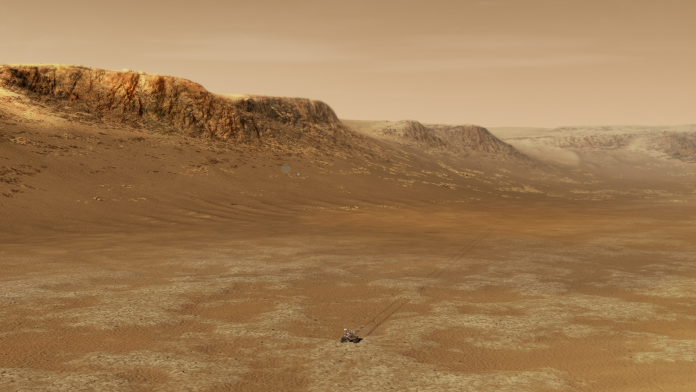NASA‘s Perservance rover will begin its descent to Mars today (18th February) in search of microbial life on the Red Planet
NASA’s Perservance rover is just hours away from landing at the Jezero Crater on Mars.
The landing site, Jezero Crater, was the site of a large lake, complete with its own river delta 3.5 billion years ago and mission scientists believe it could be home to evidence that life once existed on Mars.
Ken Williford, deputy project scientist for the Mars 2020 Perseverance rover mission at JPL, said: “We expect the best places to look for biosignatures would be in Jezero’s lakebed or in shoreline sediments that could be encrusted with carbonate minerals, which are especially good at preserving certain kinds of fossilized life on Earth, but as we search for evidence of ancient microbes on an ancient alien world, it’s important to keep an open mind.”
Sample caching system
The rover will hunt for biosignatures (evidence that life once existed there) and collect rock core samples, such as a stromatolite*, using a range of cameras and a robotic arm. Samples that are of interest can then be stored in metal tubes to be collected in future missions and taken back to Earth for analysis.
*Stromatolites are wavy, rocky mounds formed by microbial life along ancient shorelines and in other environments where metabolic energy and water were present.
The cameras on the rover, especially the Mastcam-Z, will be able to zoom in to inspect scientifically interesting targets. The mission’s team can then order the Perseverance’s SuperCam instrument to fire a laser at a target, generating a small plasma cloud that can be analysed to help determine its chemical composition.
If the data is interesting enough, the team will direct one of two instruments on the turret at the end of the rover’s robotic arm to get a closer look.

The PIXL (Planetary Instrument for X-ray Lithochemistry) will employ its tiny but powerful X-ray beam to search for potential chemical fingerprints and the SHERLOC (the Scanning Habitable Environments with Raman & Luminescence for Organics & Chemicals) instrument will use its own laser to detect concentrations of organic molecules and minerals that have been formed in watery environments.
“Yes, there are certain shapes that form in rocks where it’s extremely difficult to imagine an environment devoid of life that could cause that shape to form, but that said, there are chemical or geologic mechanisms that can cause domed layered rocks like we typically think of as a stromatolite”, added Williford.
Bobby Braun, the Mars Sample Return program manager at JPL, said: “The instrumentation required to definitively prove microbial life once existed on Mars is too large and complex to bring to Mars. That is why NASA is partnering with the European Space Agency on a multi-mission effort, called Mars Sample Return, to retrieve the samples Perseverance collects and bring them back to Earth for study in laboratories across the globe.”
“We have strong evidence that Jezero Crater once had the ingredients for life. Even if we conclude after returned sample analysis that the lake was uninhabited, we will have learned something important about the reach of life in the cosmos. Whether or not Mars was ever a living planet, it’s essential to understand how rocky planets like ours form and evolve. Why did our own planet remain hospitable as Mars became a desolate wasteland?”, concluded Williford.
The mission will be the first to collect and cache Martian rock and regolith and will pave the way for future human exploration.











